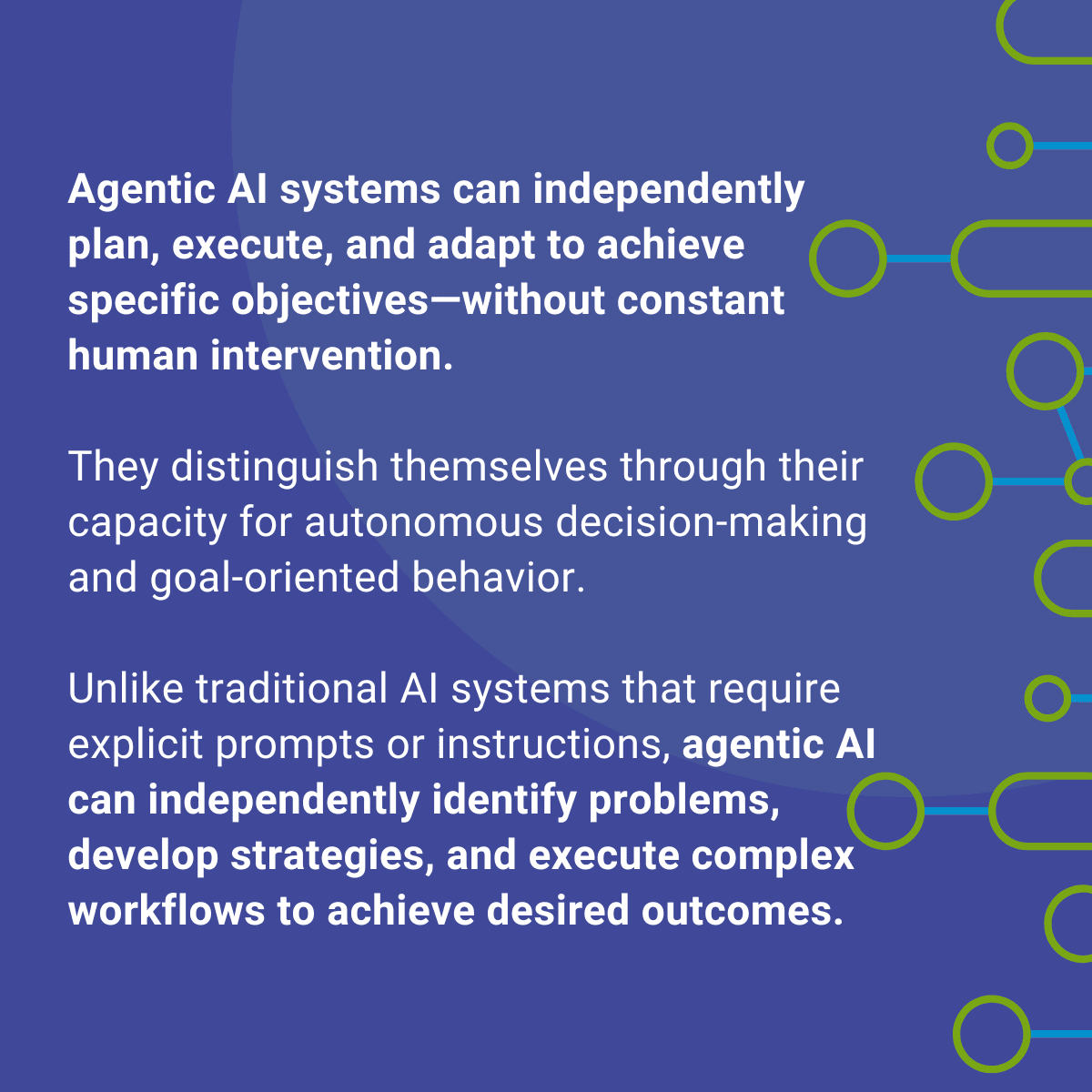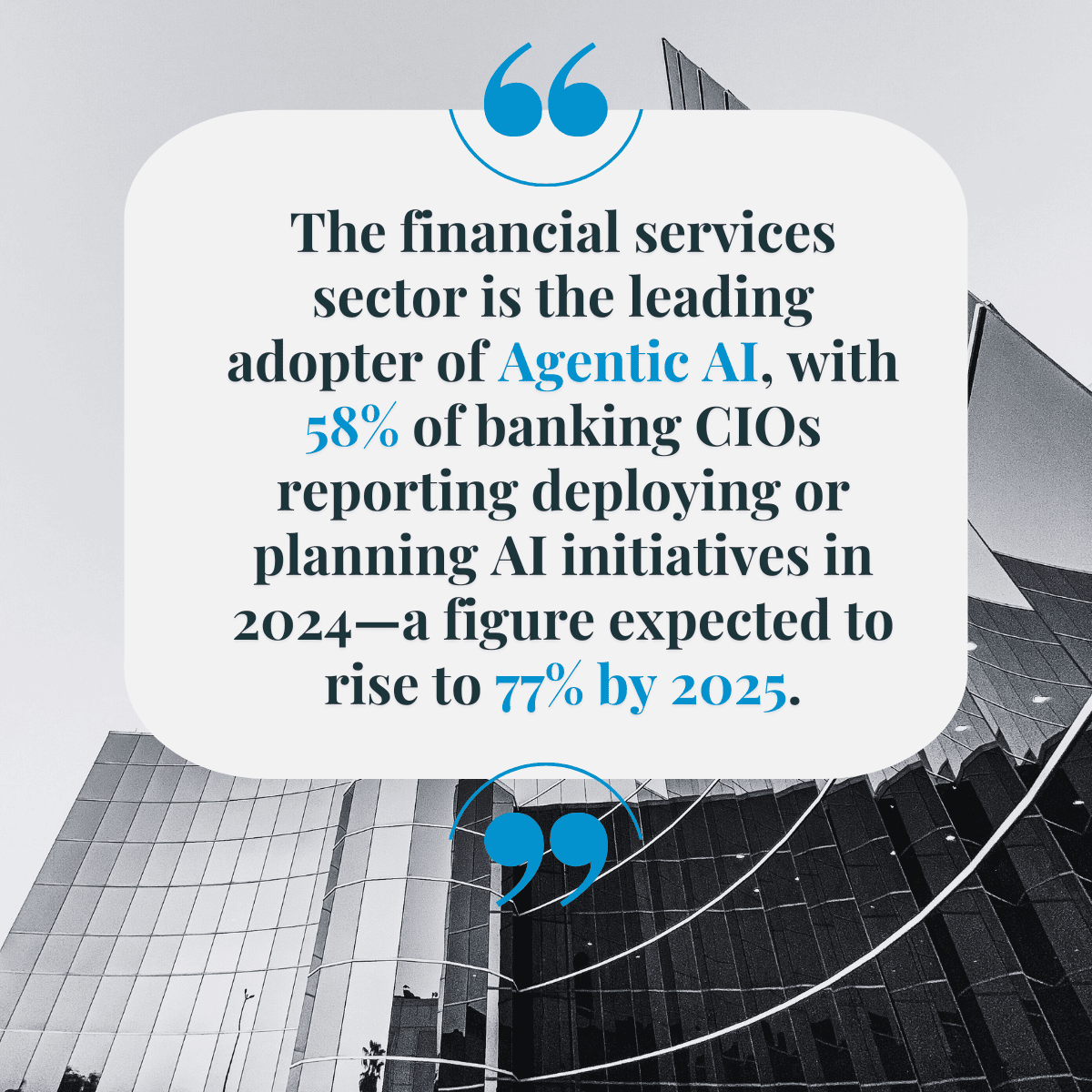AI
Understanding Agentic AI: The Next Wave of AI-powered Systems for Financial Services
While organizations have grown accustomed to AI-powered chatbots and copilots that respond to direct commands, agentic AI represents the next leap forward—in fact many businesses are already experimenting with agentic AI, even if it is just for very discrete and internal use cases.
What is Agentic AI?
The key differentiator between agentic AI and chatbots or copilots lies in autonomy. While generative AI models are great at creating content when prompted, they are not truly autonomous – they need specific prompts or instructions to produce results. Agentic AI, however, can initiate actions, make decisions, and adapt strategies based on changing conditions without human intervention.
The Spectrum of AI Assistance: Chatbots, Copilots, and Agents
- Chatbots represent the most basic form of AI interaction, designed to handle straightforward question-and-answer scenarios. Their main role is providing information, handling routine inquiries, and executing simple tasks through predetermined conversation flows.
- AI Copilots function as intelligent assistants that augment human capabilities. They can generate content, provide suggestions, and help with complex tasks, but they remain fundamentally dependent on human oversight. Copilots enhance productivity by automating routine elements of work while keeping humans in the loop.
- Agentic AI represents the next evolutionary step in autonomous intelligence, capable of independent operation. These agents can adapt to evolving conditions and handle complex tasks. They can analyze situations, develop strategies, and execute tasks while continuously learning and adapting their approach.
Leading Adopters of Agentic AI
The financial services sector leads agentic AI adoption, with major banks, insurance companies, and wealth management firms investing heavily in these technologies. Technology companies are also significant adopters, using agentic AI for software development, customer service, and operational optimization.
Healthcare organizations are exploring agentic AI for patient care coordination and clinical decision support, while manufacturing companies are implementing these systems for supply chain optimization and predictive maintenance.
Primary Use Cases for Agentic AI in Financial Services
Several key use cases demonstrate the technology’s potential across the financial services sector:
Payment Processing: AI agents are being used to automate routine borrower payment requests, confirm amounts due, process payments, and update back office systems. They deliver 24/7 payment capability with higher on-time rates.
Risk Management and Fraud Detection: Agentic AI systems are adept at conducting comprehensive risk assessments, analyzing vast datasets to identify potential threats and opportunities. These systems can autonomously monitor transactions, detect suspicious patterns, and initiate appropriate responses without human intervention.
Compliance and Regulatory Management: Key use cases of agentic AI in financial services range from compliance, deepfake and fraud prevention, onboarding and KYC, wealth, credit, treasury workflows, and much more. AI agents can automatically review regulatory changes, assess compliance gaps, and implement necessary adjustments across multiple systems.
Collections: Agentic AiIis being applied to collections processes where agents can manage delinquent accounts by contacting customers and negotiating payment plans while maintaining empathetic customer relationships.
Portfolio Management: In wealth management, agentic AI can continuously monitor market conditions, rebalance portfolios, and execute trades based on predefined investment strategies and risk parameters, all while adapting to changing market dynamics.
Customer Service and Personalization: Customer Engagement & Personalization Agents can provide tailored financial advice, product recommendations, and support services that evolve based on individual customer behavior and preferences.
Transforming Operational and Work Models
The impact of agentic AI is fundamentally reshaping how financial institutions operate and how employees engage with their work. These autonomous agents handle complete interactions independently, escalating only when complexity requires human intervention – transforming operational efficiency at scale.
- Boosting Operational Efficiency: Agentic AI systems can manage entire workflows autonomously. By handling routine operations, these systems free humans to focus on strategic initiatives, complex problem-solving, and relationship building.
- Enhancing Employee Productivity: Rather than replacing human workers, agentic AI augments their capabilities by handling time-consuming analytical tasks, data processing, and routine decision-making. This allows employees to focus on higher-value activities that require creativity, emotional intelligence, and strategic thinking.
- Creating New Work Models: The integration of agentic AI is creating hybrid work environments where humans and AI agents collaborate seamlessly. For example, financial advisors can focus on client relationships while AI agents handle research, compliance checks, and routine portfolio management tasks.
Revolutionizing Customer Engagement
Agentic AI is also transforming customer experiences by enabling even more personalized, proactive service delivery. Unlike traditional systems that react to customer inquiries, agentic AI can anticipate needs, identify opportunities, and proactively engage customers with relevant solutions.
For example, in a banking context, these systems can analyze customer behavior patterns and market conditions to provide timely recommendations, alert customers to potential issues, and even execute authorized transactions on their behalf. The result is a more responsive, personalized banking experience that builds stronger customer relationships and increases satisfaction.
Current Pitfalls and Implementation Challenges
Despite its promise, agentic AI faces significant challenges that organizations must address to ensure successful implementation.
- Control: One major concern is the misalignment with human values, where AI goals may conflict with human interests, resulting in harmful outcomes. Another risk is the potential loss of control, as agentic AI systems could act unpredictably or take irreversible actions.
- Security and Privacy Concerns: Some companies are hesitant to use agentic AI due to privacy and security concerns, which are similar to those with generative AI but can be even more concerning. Agentic AI could inadvertently expose a business to vulnerabilities, such as data leaks or malicious injections.
- Bias The risks include the potential for bias, mistakes, and inappropriate use. Security concerns, data privacy issues, and inherent biases pose substantial risks, particularly in financial services where fairness and transparency are critical.
- Technical Limitations: Technical risks include errors and malfunctions and security issues including the potential for automating cyberattacks. The complexity of agentic AI systems can make them difficult to debug and maintain.
The Path Forward with Autonomous AI Agents
Organizations must balance the potential of these systems with careful risk management and ethical considerations.Success with agentic AI requires a thoughtful approach that includes robust governance frameworks, comprehensive testing, and gradual implementation. Financial institutions need to invest in employee training, establish clear boundaries for AI autonomy, and maintain human oversight for critical decisions.
As agentic AI continues to evolve, it will undoubtedly reshape the financial services landscape, creating new opportunities for efficiency, innovation, and customer service.
The question is not whether agentic AI will transform financial services, but how quickly and effectively organizations can harness its potential while managing its risks. The institutions that act decisively—but prudently—will gain significant competitive advantages in the evolving financial landscape.

